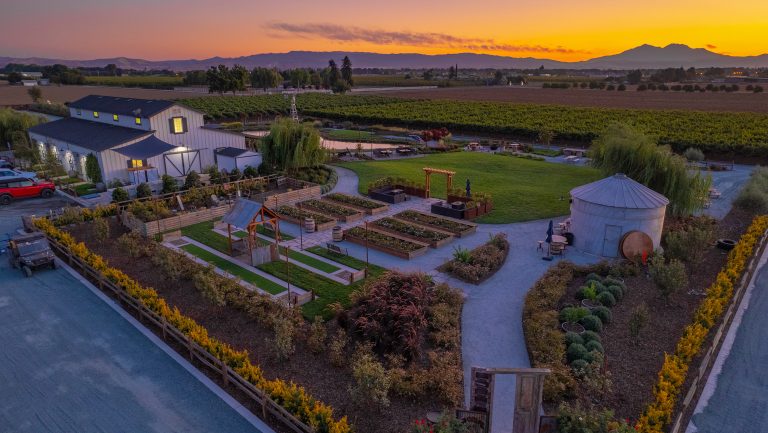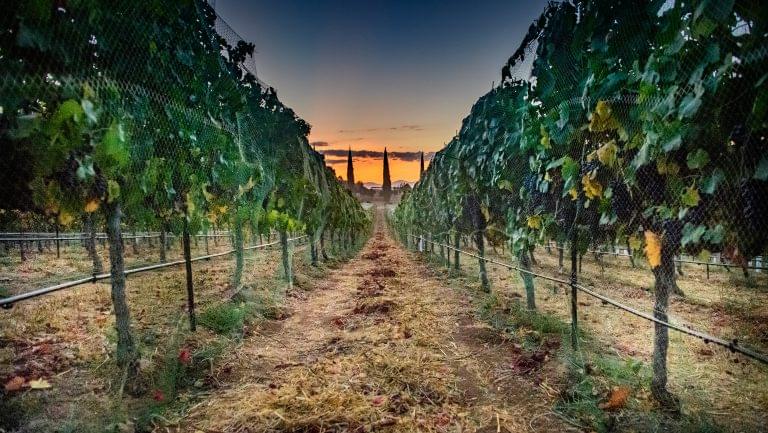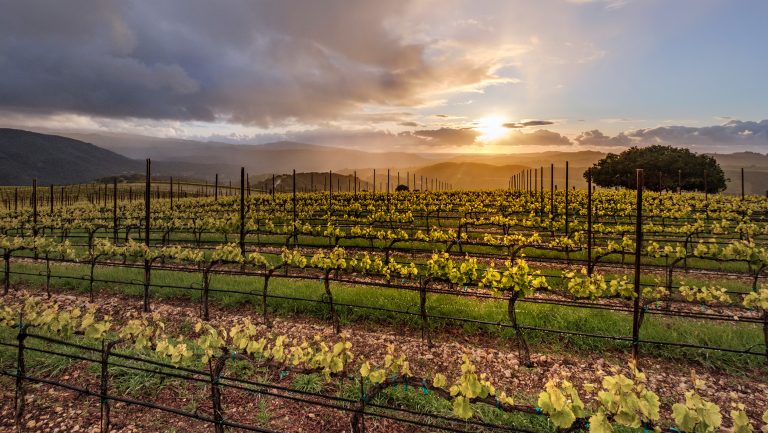Plans to recognize and further subdivide grape-growing areas of California are moving busily ahead. Right now, there are numerous proposed new California American Viticultural Areas (AVAs) in various stages of consideration by the U.S. Trade and Tobacco Bureau (TTB). Up for consideration is the first new AVA in Napa in 12 years; the historically important but recently under-the-radar winegrowing center of Contra Costa County; and the emerging Rancho Santa Fe area, where the first grapes were planted in 2005. Here is a closer look at six of the recommended AVAs.
Carmel Coast AVA
The proposed Carmel Coast AVA will sit northwest of the Carmel Valley AVA and fall completely within the Monterey AVA. “This is very much a cool-climate area,” says Patrick Shabram, the owner of a geographic consulting company, noting that temperatures are on the edge of what’s considered viable for commercial grape growing. “It’s on this slope that’s mostly south facing and is a direct shot off Carmel Bay, so you get this deep inversion layer that sits right in there. The southern exposure allows for enough solar radiation to achieve maturity in the grapes.” The soils are derived from sedimentary parent material, including Monterey shale and sandstone, and are relatively homogenous, which also differentiates it from areas further inland that have greater soil diversity.
At 4,127 acres, the Carmel Coast AVA will be on the small side. Right now, there are six growers working with Pinot Noir and Chardonnay on approximately 90 acres of vineyards. “We get substantial hang time on our fruit. That’s ideal for bringing expression and nuance to our wines,” says Brad Bowlus, the founder of Albatross Ridge Wines and Bowlus Vineyards in Carmel. “They are much more balanced in terms of acidity.” That balance creates Burgundian-style wines that are full of complexity and character and not as fruit-forward.

Don’t miss the latest drinks industry news and insights. Sign up for our award-winning newsletters and get insider intel, resources, and trends delivered to your inbox every week.
Contra Costa AVA
The petition for the Contra Costa AVA seeks to establish a new viticulture region and change the boundaries for the Central Coast and San Francisco Coast AVAs. As it stands, the Contra Costa area would fall partially in both AVAs and partially in an undesignated area. The boundary change will place Contra Costa squarely in the Central Coast AVA and create more consistency between AVA boundaries.
Part of what distinguishes the Contra Costa AVA, which falls within the county of the same name, is its history. “Before Prohibition, Contra Costa was one of the places to visit wine country,” says Shabram. Many vineyards were lost to urbanization and later, as other wine regions cropped up, lack of demand. But some of those vineyards survived, and there are now 100-year-old vines around Oakley and Martinez. Cities like Brentwood are popular destinations for agricultural tourism, and “a lot of the reason these growers are interested in an AVA is so they can make wine tasting part of those outings.”
Climate plays an important role as well. “It’s has a transitionary climate between cooler coastal climate and warmer inland,” says Shabram. Some coastal winds and fog sneak into the Suisun Bay and bring lower temperatures, but the area still experiences warmer inland temperatures too. Becky Bloomfield, the president of the Contra Costa Winegrowers Association and co-owner of Bloomfield Vineyards, notes that it can get up to 105 degrees fahrenheit during the day before cooling off overnight.

The 167,146-acre area has 1,700 acres of grapes grown by at least 60 commercial vineyards. There are currently 14 wineries. Though Zinfandel is the most common variety, there is also Petite Sirah, Mourvèdre, Chardonnay, Sauvignon Blanc, Cabernet Sauvignon, and several other types of grapes.
Crystal Springs of Napa Valley AVA
Upon approval, Crystal Springs of Napa Valley—the first new AVA in Napa since Coombsville was approved in 2011—will clock in at 4,000 acres, with 230 acres planted at 30 vineyards. It will border Old Howell Mountain Road to the east, the St. Helena AVA to the south, the Calistoga AVA to the west, and the Howell Mountain AVA to the north.
Topography is the main differentiating factor for Crystal Springs. These are mountain vineyards that stretch between 400 and 1,400 feet. “Being not too high keeps the maritime influence and diurnal temperature range, as we are not in the inversion layer,” says Steven Burgess, the president of Burgess Cellars. “This is an area that takes a lot of passion and drive to grow in, as it is not easy to farm on the hillsides compared to somewhere flat.” A southwestern aspect allows for plenty of sunshine and full maturity for fruit. The soils are mostly tuff or compressed volcanic ash, which is ideal for grapes because it has great drainage and just enough nutrition.
Cabernet Sauvignon, Cabernet Franc, and Zinfandel are the main grapes in the region. “With smaller berries and full maturity every year, the wines exhibit darker berry flavors, rich tannin structures, and more complex aromas and flavors,” says Burgess. Chefs tend to love these wines because they are dynamic and pair well with food.
Rancho Santa Fe AVA
In the early 1900s, the Rancho Santa Fe railroad company purchased a plot of land 25 miles north of San Diego to grow eucalyptus trees for railroad ties. It turned out eucalyptus was a terrible choice; not only was the wood too soft, it warped easily. The area was abandoned by the railroad and became a planned community, with many homes designed by the notable architect Lilian J. Rice.
California isn’t the only state proposing new AVAs. Petitions are being considered for unexpected appellations on the East Coast and in the Midwest

7 New AVAs in Nontraditional Winegrowing States
In 2005, Jon Williams, the co-owner of The Cov Winery, decided to plant Cabernet Sauvignon on a three quarter-acre block of his property. The resulting wine had a noticeable flavor of eucalyptus thanks to the many trees that are still planted in the area. Others were inspired by Williams’ experiment, and Rancho Santa Fe is now a nascent but burgeoning wine region with 31 vineyards on 14 acres, including Williams’ licensed winery. “These are micro-boutique vineyards run by people willing to invest in high-quality wine,” says Williams, noting that the largest vineyard has 2,500 vines.
Rancho Santa Fe is about five miles from the Pacific coast, giving it a moderate climate year-round. The average temperature is 62 degrees fahrenheit. “The terrain is more consistent than much of the South Coast AVA,” says GIS analyst and petition author Katarina Jemec Parker, with a mean elevation of 184 feet and no point higher than 553 feet. The soil parent material is sedimentary rock, sandstone, mudstone, and shale covered in loamy soil. The AVA will cover 16,000 acres. In addition to Cabernet, growers are working with Syrah, Merlot, Cabernet Franc, and Sangiovese.
San Luis Rey AVA
The San Luis Rey AVA will run from the San Diego-Riverside County border south to the towns of Oceanside and San Marcos. It roughly follows the watershed of the lower San Luis Rey River and benefits from cold breezes traveling from the Pacific Ocean into the San Luis Rey Valley.
In comparison to the South Coast AVA, which it sits entirely inside, the region is drier and has more consistent average annual temperatures and lower-than-average annual maximum temperatures, says Parker. “The proposed San Luis Rey AVA has generally older geological rock in comparison with the rest of the South Coast AVA and has a considerably higher share of sandy loam and higher share of granite and granodiorite as soil parent material. The proposed viticultural area has lower average elevation and more consistent terrain in comparison to the South Coast AVA.”
The area will be slightly under 98,000 acres with more than 256 acres planted by 44 growers. The main grape varieties are Cabernet Sauvignon, Merlot, and Cabernet Franc. Euan Parker, the winemaker for Fallbrook Winery, one of the region’s oldest brands, says the structure and flavor of Cabernet Sauvignon bears more similarity to wines coming from Sonoma than Napa. “They’re not as jammy as Napa Cabs can sometimes be,” he says. The Merlots tend to be the bolder and more powerful wines, and the Cabernet Francs “are more in the line of Saint Nicolas de Bourgueil in terms of taste.”

Rhône grapes do well because the cooler climate means an extended hang time for fruit. “The Grenaches are very boysenberry in flavor, and the Syrahs are mid-weight to heavyweight and meaty,” Euan adds. Italian grapes are also seeing some success, with Montepulciano and Aglianico doing the best for Fallbrook.
Winters Highlands AVA
The pending Winters Highlands AVA spans two counties (Yolo and Solano) and the pinch point between two geological features (Rocky Ridge and the Vaca Mountains). “It’s basically the Putah Creek watershed,” says Corinne Y. Martinez, the president and COO of Berryessa Gap Vineyards. Though the Monticello Dam now regulates the creek, the waterway has historically distributed “a big alluvial fan” through the foothills, putting down layers of gravelly loam on top of clay.
The gap between the mountains allows remnants of the coastal influence to flow in. Nearby Lake Berryessa creates a lake effect that encourages cooler air to linger. Those factors, and the 200- to 300-foot elevation of the highlands, means the area is chillier than the Sacramento Valley but still warmer than Napa, especially in the evenings.
The region will be 7,296 acres with around 134 acres under vine on 10 properties. Another 60 acres are planned for planting. “Petite Sirah does particularly well,” says Martinez. Rhône and Iberian varieties such as Grenache, Syrah, Tempranillo, Albariño, and Verdejo are also succeeding. “We get really good concentration of the true varietal characteristics,” says Martinez. “Cooler nighttime temperatures help the grapes retain acidity. We get some minerality from the gravelly loam.”

Dispatch
Sign up for our award-winning newsletter
Don’t miss the latest drinks industry news and insights—delivered to your inbox every week.
Sophia McDonald is a freelance writer who lives in Eugene, Oregon. Her work has appeared in numerous publications and on websites, including Wine Enthusiast, Eating Well, Sip Northwest, and 1859 Oregon’s Magazine.






